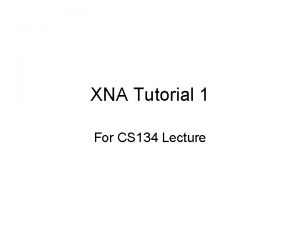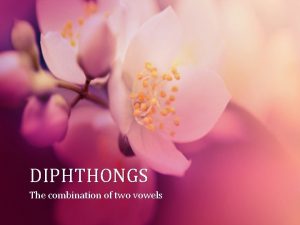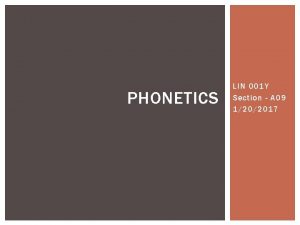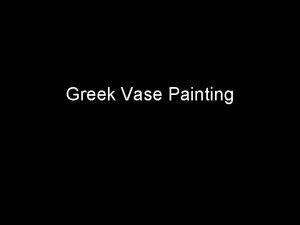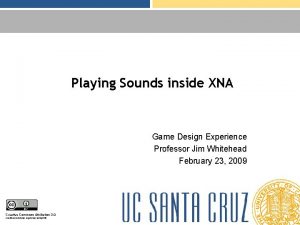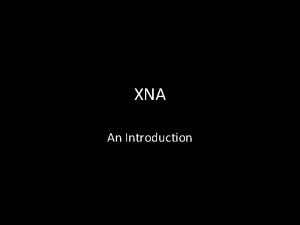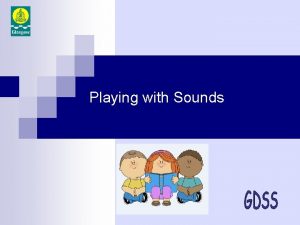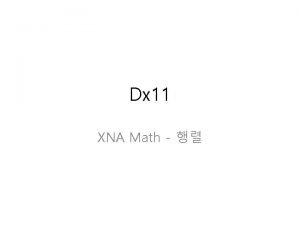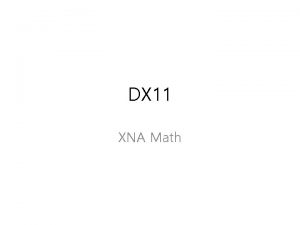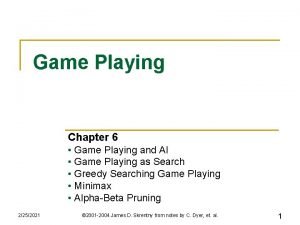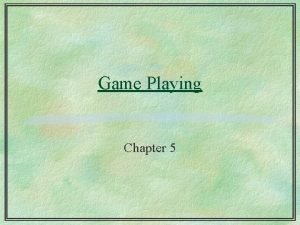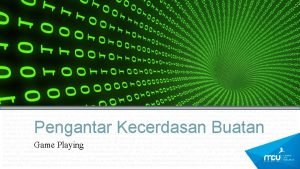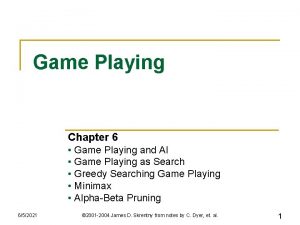Playing Sounds inside XNA Game Design Experience Professor












- Slides: 12

Playing Sounds inside XNA Game Design Experience Professor Jim Whitehead February 23, 2009 modified in part by Pramook Khungurn Creative Commons Attribution 3. 0 creativecommons. org/licenses/by/3. 0

Sound in games • Think about truly memorable games ► ► They almost always have excellent background music and sound effects Legend of Zelda, Pac. Man, Katamari Damacy, Little Big Planet, Radiant Silvergun Music and artwork style combine to create an overall tone, or mood, for a game Done well, this substantially enhances the overall gameplay experience

Finding/Making Sounds • Where can you find music to use in your game? ► ► Reminder: there is this legal framework called Copyright Law Creative Commons: use licenses that may allow free, noncommercial use • http: //creativecommons. org/ • Sites with Creative Commons licensed music ► New Grounds, Jamendo • http: //www. newgrounds. com/audio/ • http: //www. jamendo. com/en/creativecommons/ • Look for “Attribution, Non-commercial” – “No Derivative Works” is OK, so long as you don’t modify • If you use in your game, make sure you provide attribution – Put name of artist in your game (About page, splash screen, etc. ) – Is polite to send them an email telling them about the use—will make them jazzed

Finding/Making Sounds (cont’d) • Find someone to create music for you ► Music student at UCSC, for example • It has never been cheaper to create high quality music ► ► ► Instruments, microphones, mixing technology are all at historically low prices Has led to a proliferation of music Biggest problem: finding an audience Games provide a good audience Sales of many videogames larger than most music album sales For many musicians, might have larger audience for video game soundtrack than for traditional album

Finding/Making Sounds (cont’d) • Use your voice! ► Your voice is wonderfully adaptable and expressive • Consider: ► ► Record a raw voice clip Bring into an editing software suite Tweak/filter/alter until it suits your game Can do much worse… • Tools ► Audacity • http: //audacity. sourceforge. net/ • Free, open source sound recorder/editor ► FL Studio (grown-up commercial version of Fruity Loops) • http: //flstudio. image-line. com/documents/what. html

Playing Sounds in XNA • Two ways • Hard (but powerful) way ► XACT audio tool • Cross-platform audio creation tool ► ► ► Many neat features Edit volume, pitch, looping of sound clips Can easily group together sound clips • Easy (and 95% sufficient) way ► ► ► Use Simplified Sound API Can start, stop, and pause sound playing Much, much easier to use

Simple Sound API • Two ways to play music ► As a song • Good for background music, or other long sounds ► As a sound effect • Good for short duration sounds

XNA Simple Sound API • Supported music types: wav, wma, mp 3 • Add sound into project Contents folder ► ► ► Audio files treated like other files in content pipeline Copy sound file into project Contents folder Right-click on Contents folder inside Visual Studio C# Express • Add Existing Item … select audio file you just copied in ► ► Will now be visible inside Visual Studio Need to double-check the Content Processor • Sound Effect – XNA Framework – sound effects • Song – XNA Framework - songs

XNA Song API • Create a variable of type Song ► Used to load songs via the content pipeline ► Song my. Song; • Load sound file ► my. Song = Content. Load<Song>(@”{name of song file without extension}”) • To play a sound, call Play() method on Media. Player object ► Media. Player. Play(my. Song); • To pause/resume, call Pause()/Resume() on Media. Player object ► ► Media. Player. Pause(); // no argument Media. Player. Resume(); // no argument

XNA Sound Effect API • Create a variable of type Sound. Effect ► Used to load sounds via the content pipeline ► Sound. Effect sound. Effect; • Load sound file ► sound. Effect = Content. Load<Sound. Effect>(@”{name of sound file without extension}”) • To play a sound, call Play() method on Sound. Effect object ► ► Returns true if the sound effect can be played. Returns false if there are too many sound effects playing.

XNA Sound Effect API • Sound. Effect. Instance ► ► ► Represents a single playing of a sound effect. Can use this to stop, pause, and restart sound. To get one, call Create. Instance() method of Sound. Effect. Instance sound. Effect. Instance = sound. Effect. Create. Instance(); Has methods: • Play() • Pause() • Stop() ► Has properties: Is. Lopped, Pan, Pitch, and Volume

Demo of Song and Sound Effect API // Demo of use of Songs and Sound Effects inside XNA • Caution: Treating a song as a sound effect can lead to very long compile times ► Solution: keep sound effects short
 Xna game studio visual studio 2017
Xna game studio visual studio 2017 Xna framework tutorial
Xna framework tutorial Xbox xna
Xbox xna Promotion from assistant to associate professor
Promotion from assistant to associate professor Vowels and diphthongs examples
Vowels and diphthongs examples Oral sounds and nasal sounds
Oral sounds and nasal sounds Playing a decent game of table tennis (ping-pong).
Playing a decent game of table tennis (ping-pong). The most dangerous game test answers
The most dangerous game test answers Complete as interrogações abaixo usando o past continuous
Complete as interrogações abaixo usando o past continuous Jillian and dawn are playing a game
Jillian and dawn are playing a game Exekias achilles and ajax playing a dice game
Exekias achilles and ajax playing a dice game Imprinting psychology
Imprinting psychology Early experience vs later experience
Early experience vs later experience

